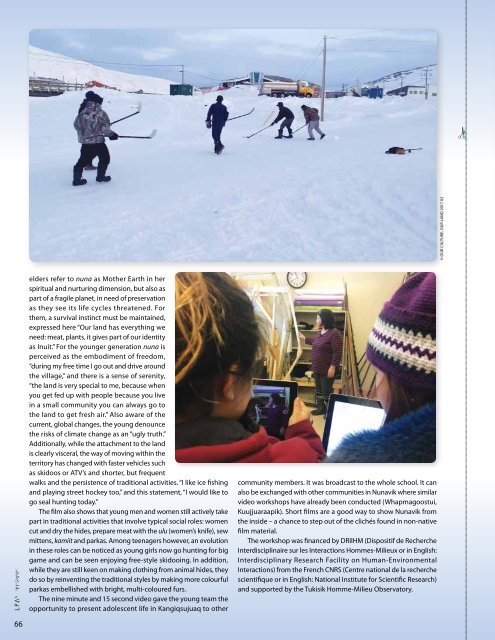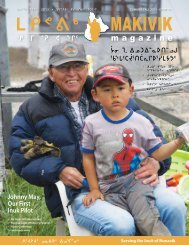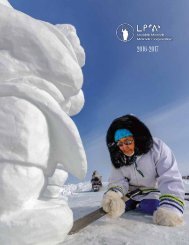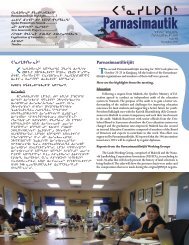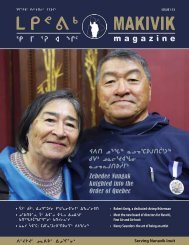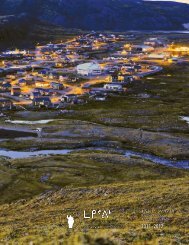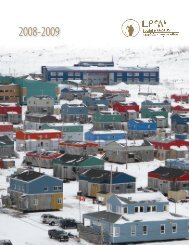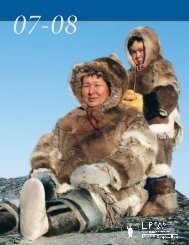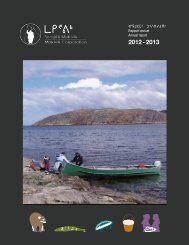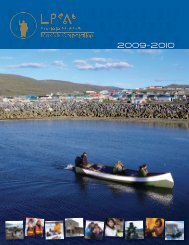Makivik Magazine Issue 115
Create successful ePaper yourself
Turn your PDF publications into a flip-book with our unique Google optimized e-Paper software.
© OUR CULTURE, OUR LAND 2017 X2<br />
ᒪᑭᕕᒃ ᕿᒥᕐᕈᐊᖏᑦ<br />
66<br />
elders refer to nuna as Mother Earth in her<br />
spiritual and nurturing dimension, but also as<br />
part of a fragile planet, in need of preservation<br />
as they see its life cycles threatened. For<br />
them, a survival instinct must be maintained,<br />
expressed here “Our land has everything we<br />
need: meat, plants, it gives part of our identity<br />
as Inuit.” For the younger generation nuna is<br />
perceived as the embodiment of freedom,<br />
“during my free time I go out and drive around<br />
the village,” and there is a sense of serenity,<br />
“the land is very special to me, because when<br />
you get fed up with people because you live<br />
in a small community you can always go to<br />
the land to get fresh air.” Also aware of the<br />
current, global changes, the young denounce<br />
the risks of climate change as an “ugly truth.”<br />
Additionally, while the attachment to the land<br />
is clearly visceral, the way of moving within the<br />
territory has changed with faster vehicles such<br />
as skidoos or ATV’s and shorter, but frequent<br />
walks and the persistence of traditional activities. “I like ice fishing<br />
and playing street hockey too,” and this statement, “I would like to<br />
go seal hunting today.”<br />
The film also shows that young men and women still actively take<br />
part in traditional activities that involve typical social roles: women<br />
cut and dry the hides, prepare meat with the ulu (women’s knife), sew<br />
mittens, kamiit and parkas. Among teenagers however, an evolution<br />
in these roles can be noticed as young girls now go hunting for big<br />
game and can be seen enjoying free-style skidooing. In addition,<br />
while they are still keen on making clothing from animal hides, they<br />
do so by reinventing the traditional styles by making more colourful<br />
parkas embellished with bright, multi-coloured furs.<br />
The nine minute and 15 second video gave the young team the<br />
opportunity to present adolescent life in Kangiqsujuaq to other<br />
community members. It was broadcast to the whole school. It can<br />
also be exchanged with other communities in Nunavik where similar<br />
video workshops have already been conducted (Whapmagoostui,<br />
Kuujjuaraapik). Short films are a good way to show Nunavik from<br />
the inside – a chance to step out of the clichés found in non-native<br />
film material.<br />
The workshop was financed by DRIIHM (Dispositif de Recherche<br />
Interdisciplinaire sur les Interactions Hommes-Milieux or in English:<br />
Interdisciplinary Research Facility on Human-Environmental<br />
Interactions) from the French CNRS (Centre national de la recherche<br />
scientifique or in English: National Institute for Scientific Research)<br />
and supported by the Tukisik Homme-Milieu Observatory.


